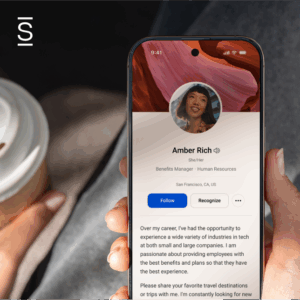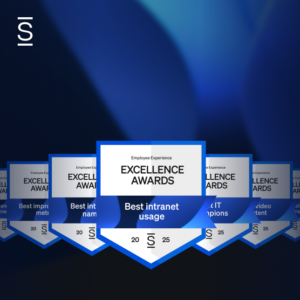There has not been a leader on Simpplr’s Cohesion Podcasts, hosted by Amanda Berry, Manager of Corporate Brand & Communications and Head of Internal Communications, that hasn’t had a surprise revelation. Whether they started outside of communications or their education and experience path was diverse, they always share a unique nugget about themselves that is remarkable. Such was the case with Carolyn Clark, Head of Internal Communications and Employer Brand at Opendoor. Her revelation? She wanted to be a news reporter from the age of three! Even though she is not a news reporter now, she believes in communication, the power of the message, and how it’s shared. That is probably why she is a success at Opendoor.
Opendoor is a real estate platform that brings technology to an antiquated process. It offers a digital, end-to-end customer experience allowing people to buy and sell easily. Considered a disruptor to the Real Estate industry, they are trying to alleviate the most stressful parts of buying or selling a home. Given the current residential property market, they are in the right place at the right time.

Internal Comms is About Connection
If there is one thing Carolyn is passionate about, it is connection. “I love connecting with people, and I love connecting [the] company mission to people,” she said. “Internal comms is making sure that our employees are understood, heard, and informed.”
Carolyn believes that a company’s brand is how businesses and organizations reach future employees. She also believes that internal communications are about relationships. That is why new Communication leaders must create a strategy around specific goals, ensuring that your transition is successful in the first 90 days. Those goals should include:
- Getting to Know Your People and Technology
- Establishing Relationships of Respect
- Create Leadership Buy-In and Participation
Not every one of these can be completely fulfilled in 90 days. However, if you see them as guidelines and take proactive steps, you will effectively reach them in a short amount of time.
Getting to Know the People and Technology
Carolyn explained that your first 30 to 60 days is about testing your knowledge of people and technology. As for people, she explained that “If I hear someone’s name that I’m not familiar with, I pull up that org chart.” In other words, familiarize yourself with colleagues’ and employees’ roles and responsibilities.
Next, try to understand your company’s operating models. For Carolyn, it meant comprehending the company’s tech stack. You need to know the technological capabilities of your company and feel confident enough to talk about it. The next part is assessing your company’s tools, knowing the channels they use, and how they are being utilized. Lastly, identify how your company tracks your content. While this all may be basic information, it is essential to your core company knowledge.
According to Carolyn, this process will take a significant amount of listening and reading. She joked with her boss that she felt like she was studying for a test. So, print your information out, and reference it when needed.
Relationships of Respect
Carolyn shared one valuable learning regarding relationships: treating everyone with respect is key to a Communications Leader’s role. Every day you will meet people, and you must understand them and see things from their perspective. Another level of this perspective to consider is the difference in thinking between tenured and new employees. Having a good and empathetic leader above you can aid in your own onboarding. Their guidance can go very far.
Being honest and vulnerable with who you are is also a part of a relationship of respect. Carolyn shared that in just a few moments in front of people, being unguarded and showing others authenticity opens the door for reciprocation and connection. By sharing who you are allows others to do the same.
The Three Pillars: Empathy, Advocacy, and Truth
According to Carolyn, when coming into a new space as a Communications leader, you need to view internal comms through the lens of empathy, advocacy, and truth. She refers to them as the Three Pillars. Carolyn believes that you’re doing your job right when you have these to stabilize your organization. The pillars are especially helpful when onboarding new employees or welcoming them due to a merger or acquisition.
Carolyn, however, cautioned about what could happen if internal comms are not involved in this process. The general use of ICs is about the message and type of messaging that your company wants to send, especially during mergers or acquisitions. Communications must partner with HR well to help people adjust to the culture, become engaged, and acclimated during a time of transition. You want to provide the best employee experience possible.
The reality is that many may be facing impending job loss. Great empathy helps both the Internal Comms organization and HR identify the employees who need help and then help them on their path as they leave. One proactive way to do this is by answering what Carolyn calls the “Me” questions. The main question would be, “How does this affect me?”
Be prepared to talk to people about their job, their futures, and all accompanying subjects around employment. Carolyn shared this bit of wisdom. “As internal communicators who are based or rooted in this idea of empathy, you know, empathizing with the employee, advocating for their needs and then telling the truth, even if the truth is uncomfortable with that mentality in the merger and acquisition space, you can get much farther, much quicker.”
Additionally, Carolyn thinks internal comms must be used to integrate people into the company. First, from a tactical standpoint, internal comms can guide leadership by relaying the proper message about any situation. Without that transparency, people will begin to make up their own narratives. So, provide the story that needs to be heard. Second, from just being in the room as a witness to the process, internal comms is thereby a platform for facts and truth.
Internal comms are about both sharing and receiving. By listening to the people going through the process, you can connect to HR and leadership regarding what employees are concerned about. Lastly, internal comms can advocate for the employee. As an IC leader, you are the company’s eyes, ears, and mouth. But the transfer of the message and knowledge must go both ways.
Leadership Buy-In and Participation
The last area to focus on is the often difficult task of getting leaders engaged in the internal communication process and strategy. Carolyn’s sage advice was both interesting and insightful.
“It’s figuring out how to ‘talk’ their game, ” she said. “I mean, it is figuring out what they care about and then using that to prove your case. Whether it’s data, whether it’s sentiment, whether it’s content, or whatever it is. I think if you want somebody to believe what you’re doing matters, you have to learn to speak their language.”
Once again, it is about knowing how to approach your audience. In this case, it understands the business of your employer. While this may seem fundamental, most IC people view things differently. They don’t need to go deep into the business because they’re communicating at the highest level point of view, sometimes referred to as the 1000 foot view. However, according to Carolyn, “in order to speak the language of engineering leaders, or even your CEO and your C-suite, you have to understand what makes them tick.”
Anything that matters must be put in front of different leaders with different strategies. Your ultimate plan may be the same as your goal. However, how you approach it and get buy-in may differ. A key question? “What matters to you?” This action may not be easy if you are new. But it can be done.
The next step, document the response. Carolyn went through this process in the first few weeks at Opendoor. She keeps it all in a “little black book.” Every time she meets with someone, she takes notes and refers back to them when needed.
The last part is always being prepared for your interactions with stakeholders and leaders.
“If I have to present something to them or I need their buy-in, I can kind of change my approach a little bit so that I can speak their language or remember something about them. That’s important just to get that trust. So, I would say put the effort into getting to know the people you want to buy in so that you can sell to them.”
To listen to the rest of Carolyn’s insights and tales of PR in the entertainment and tech industries, tune into the Cohesion Podcast on Spotify or Apple Pocasts.

















